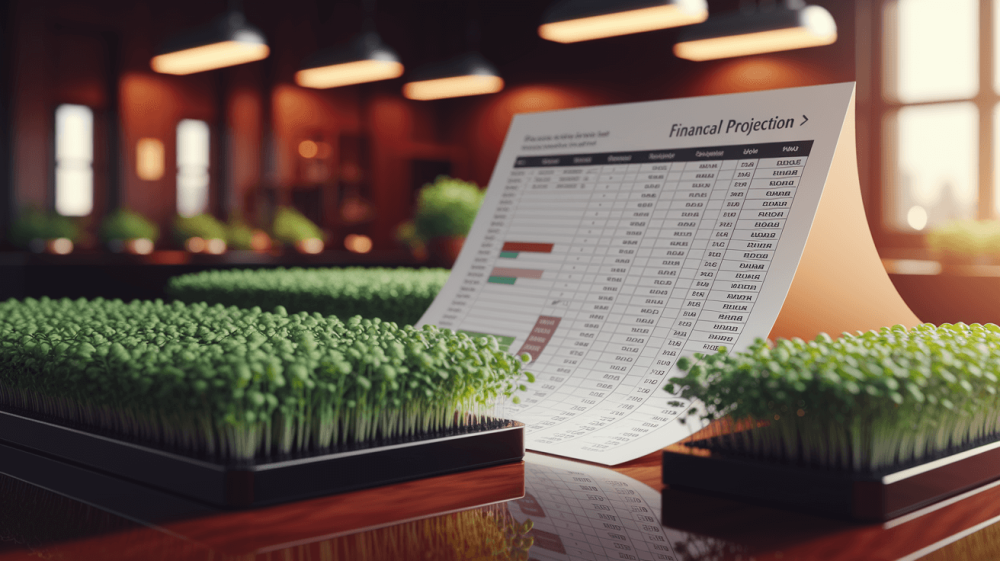Want to turn your microgreens passion into a profitable business?
You’ll need a solid business plan. In this comprehensive guide, I’ll walk you through creating a professional microgreens business plan that will impress investors, guide your growth, and dramatically increase your chances of success.
Discover how to start a successful Microgreens Business From Scratch, So You Can Make Your First $2k+ in 30 days Just Using a Corner Of Your Room… Access Free Training Here >>
I’ll provide a complete template with real-world examples from successful microgreens businesses, along with downloadable resources you can customize for your own venture.
According to a survey of agricultural startups, businesses with detailed written plans are 2.5x more likely to secure funding and 30% more likely to achieve profitability in their first year (Small Business Administration, 2024).
For microgreens entrepreneurs specifically, a business plan isn’t just paperwork—it’s your roadmap to success.
Let’s create your blueprint for a thriving microgreens business.
Table of Contents
Why You Need a Microgreens Business Plan
A microgreens business plan isn’t just a document you create and forget. It serves multiple vital purposes:
- Clarifies Your Vision – Forces you to define exactly what your business will look like and how it will operate
- Identifies Market Opportunities – Helps you research and understand your target market
- Reveals Potential Problems – Exposes challenges before you invest significant time and money
- Guides Decision-Making – Provides a framework for evaluating opportunities and making choices
- Attracts Financing – Essential if you need to secure loans, grants, or investors
As one successful microgreens entrepreneur told me: “I thought my business plan was just something I needed for the bank. It turned out to be the document that saved my business multiple times when I faced tough choices.”
Even if you’re starting small, a business plan forces you to think through critical aspects of your business before you commit resources. For microgreens specifically, it helps you determine:
- Which varieties will be most profitable in your market
- What equipment you’ll need and when
- How to price your products competitively yet profitably
- Which sales channels to prioritize
- How to scale efficiently as you grow

Business Plan Template Overview
Your microgreens business plan should include these 10 key sections:
- Executive Summary – Brief overview of your entire plan
- Company Description – Legal structure, mission, vision, and values
- Market Analysis – Industry trends, target market, and competition
- Products and Services – Your microgreens varieties and any additional offerings
- Marketing and Sales Strategy – How you’ll attract and retain customers
- Production Plan and Operations – Growing methods, equipment, and processes
- Management and Organization – Your team and advisors
- Financial Projections – Startup costs, sales forecasts, and profitability analysis
- Funding Requirements – Capital needs and how funds will be used
- Appendix – Supporting documents and research
Let’s explore each section in detail with real examples from successful microgreens businesses.
Executive Summary Section
The executive summary is a concise overview of your entire business plan. Though it appears first, you should write it last, after completing all other sections.
What to Include:
- Business concept in 1-2 sentences
- Market opportunity and target customers
- Competitive advantage/unique selling proposition
- Business model summary
- Financial highlights and projections
- Team strengths (if applicable)
- Current stage and major achievements
- Funding needs (if seeking investment)
Example Executive Summary:
“Urban Microgreens LLC is a premium microgreens producer serving high-end restaurants and health-conscious consumers in the Phoenix metropolitan area. The company will grow organic, locally-produced microgreens year-round using sustainable methods.
The $2.2 billion microgreens market is growing at 11.3% annually, with particularly strong demand in the Southwest where fresh, local produce is limited. Urban Microgreens differentiates itself through chef-designed specialty varieties, consistent weekly delivery, and sustainable growing practices.
The company will operate from a 1,200 sq ft climate-controlled production facility with projected first-year sales of $96,000 growing to $240,000 by year three. Initial startup costs of $25,000 will fund equipment purchases and three months of operating expenses.
Founder Maria Chen brings ten years of experience in commercial hydroponics and established relationships with 15 local restaurants. Urban Microgreens has already secured commitments from six restaurants representing $3,200 in monthly recurring revenue.”
Pro Tips:
- Keep it under one page
- Focus on what makes your business unique
- Include specific numbers rather than generalities
- Use confident, clear language
- Highlight your most impressive projections or achievements

Company Description Section
The company description provides fundamental information about your business structure, purpose, and vision.
What to Include:
- Legal business name and structure (LLC, sole proprietorship, etc.)
- Mission statement (your purpose)
- Vision statement (future aspirations)
- Core values
- Business location and facilities
- Brief history (if already operating)
- Short-term and long-term objectives
- Owner background and qualifications
Example Company Description:
“Growing Green Microgreens is a limited liability company registered in Colorado. Our mission is to provide the freshest, most nutritious microgreens to promote health and sustainability in our community.
Mission: To grow exceptional quality microgreens that enhance the health of our customers and the sustainability of our local food system.
Vision: To become the premier microgreens supplier in Colorado, recognized for product quality, sustainable practices, and community engagement.
Core Values:
- Exceptional Quality: We grow only the best
- Environmental Stewardship: We use sustainable practices
- Community Connection: We support local food systems
- Continuous Improvement: We constantly refine our methods
The business operates from a purpose-built 800 sq ft growing facility in Boulder, using vertical farming techniques to maximize production in a small footprint. The facility includes dedicated areas for seeding, growing, harvesting, packaging, and cold storage.
Founder James Wilson holds a BS in Horticulture from Colorado State University and has completed specialized training in commercial microgreens production through the Urban Farming Institute. Before launching Growing Green, James managed crop production for Boulder Organic Farms.”
Pro Tips:
- Craft a mission statement that expresses why your business exists beyond making money
- Include qualifications that specifically relate to microgreens or agriculture
- Be specific about your business structure and ownership
- Highlight any special features of your growing facilities
Market Analysis Section
The market analysis demonstrates your understanding of the industry, target customers, and competitive landscape.
What to Include:
- Industry overview and trends
- Target market size and growth potential
- Customer segments and their needs
- Detailed competitor analysis
- Your competitive advantages
- Regulatory considerations
- Market research methodology and findings
Example Market Analysis:
“The global microgreens market is projected to reach $2.2 billion by 2028, growing at 11.3% annually (Market Research Future, 2023). Key growth drivers include increasing consumer interest in nutritional foods, chef adoption in high-end restaurants, and year-round local production capabilities.
Local Market Opportunity:
Seattle’s food scene includes 340+ independent restaurants, with 42% emphasizing local, sustainable ingredients according to Seattle Restaurant Alliance data. Additionally, the region has 16 weekly farmers markets serving approximately 62,000 visitors, and 12 premium grocery stores that feature local produce sections.Primary Customer Segments:
- Fine Dining Restaurants (40% of projected revenue)
- Needs: Consistent quality, unique varieties, reliable delivery
- Average order: 5-8 lbs weekly at $25-30/lb
- Decision maker: Executive Chef
- Health-Conscious Consumers (30% of projected revenue)
- Needs: Nutritional benefits, organic certification, convenience
- Average order: 4-8 oz subscription at $4-6/oz
- Demographics: 25-45 years old, household income $75k+
- Premium Grocery Stores (20% of projected revenue)
- Needs: Attractive packaging, extended shelf life, consistent supply
- Average order: 10-15 lbs weekly at $20-25/lb
- Decision maker: Produce Department Manager
Competitor Analysis:
Three primary competitors serve the Seattle market:
Competitor Strengths Weaknesses Our Advantage Seattle Greens Established (8 years), 25+ restaurant clients Limited variety (6 types), not certified organic 15+ specialty varieties, organic certification Emerald City Micros Strong retail presence, attractive packaging Inconsistent availability, higher prices Weekly subscription model, competitive pricing Pike’s Sprouts Large production capacity, wholesale focus Lower quality, not locally focused Premium quality, truly local (10-mile radius) Regulatory Environment:
Washington State requires a Food Processor’s License ($92 annually) and compliance with WSDA good agricultural practices. All products must be labeled according to state guidelines, including harvest date and handling instructions.”
Pro Tips:
- Use specific data and statistics, citing credible sources
- Conduct firsthand research through customer interviews and market observation
- Analyze competitors thoroughly, including their pricing, quality, and marketing
- Identify clear market gaps your business will fill
- Segment your market precisely rather than targeting “everyone”

Products and Services Section
This section details exactly what you’ll sell, emphasizing your unique qualities and benefits.
What to Include:
- Complete list of microgreens varieties
- Product specifications (packaging sizes, formats)
- Quality standards and certifications
- Pricing structure
- Product lifecycle (shelf life, seasonal availability)
- Intellectual property (if applicable)
- Future product development plans
Example Products and Services:
“Northwest Microgreens offers premium-quality, organic microgreens in three product categories:
1. Signature Varieties (60% of production)
- Sunflower: Nutty flavor, hearty texture, 10-day growth cycle
- Pea Shoots: Sweet flavor, crisp texture, 12-day growth cycle
- Radish: Spicy flavor, colorful presentation, 8-day growth cycle
- Broccoli: Mild flavor, exceptional nutrition, 10-day growth cycle
- Cilantro: Aromatic, distinctive flavor, 16-day growth cycle
2. Chef’s Selection (25% of production)
- Custom microgreens blends developed with local chefs
- Seasonal specialty varieties (amaranth, shiso, sorrel)
- Edible flowers complementing microgreens
- Custom-grown varieties for exclusive restaurant use
3. Consumer Products (15% of production)
- Weekly Subscription Box: Rotating selection of 3 varieties, 6oz total
- Microgreens Starter Kit: Seeds, growing medium, instructions
- DIY Growing Workshop (monthly, in-person)
- Microgreens Recipe Collection (digital product)
Packaging Options:
- Restaurant: 1lb and 5lb bulk bags with handling instructions
- Retail: 2oz and 4oz compostable clamshells with nutritional information
- Subscription: Custom branded reusable containers
Quality Standards:
All products are USDA Certified Organic and grown according to strict quality control protocols. Each batch undergoes microbial testing and must meet appearance, flavor, and texture standards before sale.Pricing Strategy:
- Restaurant Wholesale: $25-30/lb depending on variety
- Retail Packages: $3.50-5.00/oz depending on variety
- Subscription: $25/week for 6oz weekly delivery
Future Product Development:
Development is underway for value-added products including microgreens pesto, dried microgreens powder, and microgreens growing kits for chefs.”
Pro Tips:
- Include detailed descriptions of your most important varieties
- Highlight any proprietary growing techniques or unique varieties
- Explain why your product quality exceeds competitors
- Use exact pricing rather than ranges when possible
- Include photos or diagrams of your packaging in the appendix
Marketing and Sales Strategy
This section outlines exactly how you’ll attract customers and sell your microgreens.
What to Include:
- Positioning and branding strategy
- Marketing channels and tactics
- Sales process for each customer segment
- Customer acquisition costs
- Customer retention strategies
- Marketing budget allocation
- Key messaging and unique selling proposition
- Marketing timeline and milestones
Example Marketing and Sales Strategy:
“Fresh City Microgreens will implement a targeted marketing strategy focused on building strong brand recognition among chefs and health-conscious consumers.
Branding Strategy:
Our brand will emphasize three key attributes:
- Ultra-freshness (harvested <24 hours before delivery)
- Chef-approved quality (developed with culinary input)
- Urban-local production (grown within 5 miles of customers)
Visual branding includes a modern, minimalist logo featuring our signature microgreen (red amaranth) and a consistent color palette of green, white, and black across all materials.
Customer Acquisition Strategies by Segment:
1. Restaurant Customers
- Direct chef outreach with sample kits (10 contacts weekly)
- Chef’s collaborative dinner series (quarterly)
- Culinary school partnerships and demonstrations
- Industry trade show participation (2 annually)
2. Retail Consumers
- Farmers market presence (2 weekly markets, April-October)
- Educational workshops at health food stores
- Social media content marketing (Instagram focus)
- Local food blogger partnerships and influencer outreach
3. Grocery Partners
- In-store demonstrations with sampling
- Cross-promotion with complementary products
- Produce manager education program
Digital Marketing:
- Website with online ordering capability
- SEO focused on local search terms
- Weekly Instagram content (growing process, harvest photos, recipes)
- Monthly email newsletter with seasonal offerings
- Google Business Profile optimization
Sales Process – Restaurant Example:
- Identify target restaurants aligned with our quality positioning
- Research chef and menu to customize outreach
- Initial contact via email with follow-up call
- Schedule in-person meeting with sample kit
- Trial order period (typically 2 weeks)
- Conversion to standing weekly order
- Monthly check-ins for variety rotation and satisfaction
Customer Retention:
- Chef appreciation program (quarterly events)
- Loyalty program for subscription customers (every 10th delivery free)
- Seasonal variety introductions to maintain interest
- Personalized harvest scheduling for key accounts
Marketing Budget:
First-year marketing allocation: $7,200 ($600 monthly)
- Sampling program: 35%
- Digital marketing: 25%
- Print materials: 15%
- Events and demonstrations: 15%
- Website maintenance: 10%”
Pro Tips:
- Focus on low-cost, high-impact strategies specific to microgreens
- Create separate strategies for each customer segment
- Include specific numbers (frequency, costs, targets)
- Explain how you’ll measure marketing effectiveness
- Include examples of your brand voice and messaging
Production Plan and Operations
This section details your growing systems, production capacity, and operational procedures.
What to Include:
- Growing methodology and techniques
- Facility layout and specifications
- Equipment list and costs
- Production capacity analysis
- Supply chain and vendor relationships
- Inventory management system
- Quality control procedures
- Production schedule and timing
- Staffing requirements
- Environmental controls and monitoring
Example Production Plan:
“Harvest Urban Farms will operate a 1,500 sq ft indoor vertical growing facility capable of producing 200-250 lbs of microgreens weekly at full capacity.
Growing Methodology:
We will use a soil-based growing system with organic certified potting mix in standard 10″x20″ growing trays. This method was selected after testing both soil and hydroponic systems, with soil producing superior flavor profiles and requiring less technical expertise.Facility Layout:
Our production space includes five distinct zones:
- Seeding Area (200 sq ft): Workbenches, seed storage, soil preparation
- Blackout Zone (200 sq ft): Temperature-controlled shelving for germination
- Growing Zone (800 sq ft): Vertical racking with LED lighting
- Harvest/Packaging Area (200 sq ft): Food-grade work surfaces, scale, packaging equipment
- Cold Storage (100 sq ft): Walk-in cooler for harvested product
Equipment Requirements:
Equipment Quantity Cost Purpose Growing Racks 10 $3,000 6-tier vertical production LED Grow Lights 60 $4,500 Full-spectrum growing lights Climate Control 1 system $2,000 Temperature and humidity management Seeding Equipment Various $800 Precision seeding tools Harvesting Tools Various $500 Food-grade scissors, knives, containers Packaging Equipment Various $1,200 Scale, heat sealer, labeler Walk-in Cooler 1 $4,000 Post-harvest storage Monitoring System 1 $800 Environmental parameter tracking Total $16,800 Production Capacity:
At full operation, our facility will maintain:
- 150 trays in blackout germination phase
- 300 trays in active growing phase
- Daily harvest capacity of 40-50 trays
- Weekly production of 200-250 lbs
Production Schedule:
We will implement a perpetual growing cycle with daily seeding and harvesting:
- Monday-Friday: Seeding (30 trays daily)
- Monday-Saturday: Harvesting (40-50 trays daily)
- Sunday: Facility maintenance only
Quality Control Procedures:
- Seed Quality: Testing germination rates for each seed lot
- Growing Conditions: Automated monitoring of temperature, humidity, and light levels
- Visual Inspection: Daily checks for disease or contamination
- Harvest Standards: Color, height, and flavor assessment before harvest
- Post-Harvest: Random sampling for microbial testing monthly
Supply Chain:
We have established relationships with two primary seed suppliers:
- Johnny’s Selected Seeds (primary supplier)
- True Leaf Market (backup supplier)
Soil medium is sourced locally from Green City Compost with backup supplier relationships established. Packaging materials are ordered quarterly from EcoGrow Packaging.
Staffing Plan:
Initial operations will require:
- 1 full-time production manager (owner)
- 1 part-time production assistant (20 hrs/week)
- 1 part-time harvest/delivery person (15 hrs/week)”
Pro Tips:
- Include a facility floor plan in your appendix
- Detail your growing method and why you’ve chosen it
- Create contingency plans for equipment failure or crop issues
- Be specific about production capacity and growth limitations
- Document key vendor relationships and alternatives
Discover how to start a successful Microgreens Business From Scratch, So You Can Make Your First $2k+ in 30 days Just Using a Corner Of Your Room… Access Free Training Here >>

Financial Projections
Financial projections demonstrate the viability of your business model and show when you’ll become profitable.
What to Include:
- Startup costs breakdown
- Sales forecast (monthly for year 1, quarterly for years 2-3)
- Profit and loss projections
- Cash flow statement
- Break-even analysis
- Key financial metrics and ratios
- Financial assumptions explanation
- Sensitivity analysis (best/worst case scenarios)
Example Financial Projections:
“Metro Microgreens projects profitability in month 7 with initial startup costs of $31,500 and monthly operating expenses of $4,200.
Startup Costs:
Category Amount Details Equipment $18,500 Growing racks, lights, climate control, packaging Facility Setup $5,000 Plumbing, electrical, shelving installation Initial Inventory $2,500 Seeds, soil, packaging materials Legal & Licensing $1,500 LLC formation, permits, insurance Marketing $2,000 Website, branding, initial promotion Operating Reserve $2,000 3 months operating capital Total $31,500 Revenue Projections – Year 1:
Quarter Revenue Cost of Goods Gross Profit Operating Expenses Net Profit Q1 $15,000 $6,000 $9,000 $12,600 ($3,600) Q2 $30,000 $12,000 $18,000 $12,600 $5,400 Q3 $45,000 $18,000 $27,000 $15,000 $12,000 Q4 $60,000 $24,000 $36,000 $18,000 $18,000 Year 1 $150,000 $60,000 $90,000 $58,200 $31,800 Projected Growth:
- Year 1: $150,000 revenue / $31,800 net profit (21% margin)
- Year 2: $250,000 revenue / $60,000 net profit (24% margin)
- Year 3: $375,000 revenue / $105,000 net profit (28% margin)
Break-Even Analysis:
With fixed monthly costs of $4,200 and an average gross margin of 60%, monthly revenue of $7,000 is required to break even. At projected growth rates, break-even will occur in month 5.Key Financial Metrics:
- Gross Margin: 60%
- Net Profit Margin (Year 1): 21%
- Return on Investment: 101% (first year)
- Customer Acquisition Cost: $45 (restaurants), $18 (retail customers)
- Average Order Value: $125 (restaurants), $25 (retail)
Financial Assumptions:
- Growing capacity will increase 25% each quarter in Year 1
- Labor costs will increase with volume (additional staff in Q3)
- Price per pound will remain constant at $28 wholesale
- Production efficiency will improve by 10% by end of Year 1
- Marketing expenses will scale with revenue (8% allocation)
Sensitivity Analysis:
In a worst-case scenario (25% below projections), the business remains viable with delayed profitability in month 11. In a best-case scenario (25% above projections), profitability would be achieved in month 4 with first-year profit of $55,000.”
Pro Tips:
- Be conservative in your revenue projections
- Account for seasonality in both demand and growing conditions
- Include detailed explanations of your assumptions
- Prepare multiple scenarios (conservative, expected, optimistic)
- Use industry benchmarks where available to support your projections
- Consider creating financial projections with the help of an accountant

Funding Requirements and Use of Funds
If you’re seeking investment or loans, this section explains how much money you need and exactly how you’ll use it.
What to Include:
- Total funding required
- Funding timeline and tranches (if applicable)
- Detailed allocation of funds
- Impact of funding on growth and profitability
- Potential funding sources
- Terms you’re seeking
- Exit strategy for investors (if applicable)
Example Funding Requirements:
“Fresh Greens Co. is seeking $50,000 in initial funding to establish operations and reach profitability. The owner will contribute $15,000 in personal capital, with $35,000 sought from external sources.
Funding Allocation:
Category Amount Percentage Purpose Equipment $22,000 44% Production systems, lighting, packaging equipment Facility Buildout $10,000 20% Space preparation, utilities installation Initial Inventory $3,000 6% Seeds, growing medium, packaging Marketing $5,000 10% Website, branding, launch campaign Working Capital $10,000 20% 6 months operating expenses Total $50,000 100% Funding Impact:
This investment will:
- Establish a facility capable of $180,000 annual revenue
- Create 3 part-time jobs within the first year
- Achieve profitability by month 7
- Generate projected Year 3 revenue of $350,000
Preferred Funding Sources:
- SBA Microloan ($35,000)
- Alternative: Angel investor with agriculture experience
Terms Sought:
- 5-year term loan
- 6-12 month initial payment deferral period
- Interest rate at or below 8%
Return on Investment:
Based on financial projections, the business will be able to repay a $35,000 loan with 8% interest over 5 years while maintaining positive cash flow. Total interest over the loan term would be approximately $7,500.Exit Strategy:
While this is primarily a lifestyle business, potential exit strategies for investors include:
- Owner buyout after Year 3 (from accumulated profits)
- Sale to larger urban agriculture company
- Expansion franchise opportunity development”
Pro Tips:
- Be extremely specific about how funds will be used
- Connect funding to concrete growth outcomes
- Demonstrate your personal financial commitment
- Research and reference specific funding sources you plan to approach
- Describe why your business represents a good investment opportunity
- Be realistic about funding terms you can support
Discover how to start a successful Microgreens Business From Scratch, So You Can Make Your First $2k+ in 30 days Just Using a Corner Of Your Room… Access Free Training Here >>
Growth Strategy and Milestones
This section outlines your long-term vision and the specific steps you’ll take to grow your business.
What to Include:
- Long-term vision (3-5 years)
- Growth strategies and tactics
- Specific milestones with dates
- Key performance indicators (KPIs)
- Potential challenges and contingency plans
- Future product/market opportunities
- Scaling considerations
Example Growth Strategy:
“Urban Sprouts will follow a three-phase growth strategy to expand from local microgreens producer to regional food innovation company.
Phase 1: Establishment (Months 1-12)
Key Milestones:
- Month 1-2: Facility setup and initial production tests
- Month 3: First restaurant clients secured (minimum 3)
- Month 5: Break-even achieved
- Month 6: Farmers market presence established
- Month 9: Subscription service launched
- Month 12: $120,000 annual run rate achieved
Success Metrics:
- Production capacity: 150 lbs weekly
- Client base: 12+ restaurants, 25+ subscribers
- Revenue: $10,000+ monthly by year end
- Production efficiency: 85%+ germination rate
Phase 2: Optimization and Expansion (Months 13-24)
Key Milestones:
- Month 14: Production automation implementation
- Month 16: Retail packaging redesign and launch
- Month 18: Second growing room expansion
- Month 20: First value-added product development
- Month 24: $250,000 annual run rate achieved
Success Metrics:
- Production capacity: 350 lbs weekly
- Labor efficiency: 20% improvement per pound
- Client base: 25+ restaurants, 100+ subscribers
- Product line: 12+ varieties plus 2 value-added products
Phase 3: Market Expansion (Months 25-36)
Key Milestones:
- Month 26: Regional grocery chain partnership
- Month 28: E-commerce platform launch
- Month 30: Second facility scouting/planning
- Month 33: Cookbook or educational product launch
- Month 36: $450,000 annual run rate achieved
Success Metrics:
- Geographic coverage: 50-mile radius from production
- Retail presence: 15+ stores
- Product line: 18+ varieties plus 5 value-added products
- Digital reach: 10,000+ social media followers
Growth Challenges and Contingency Plans:
Challenge: Production Constraints
- Primary Plan: Vertical expansion within existing facility
- Contingency: Contract growing partnership with local farm
Challenge: Seasonal Demand Fluctuations
- Primary Plan: Balanced customer portfolio across sectors
- Contingency: Seasonal variety and product adjustments
Challenge: Increased Competition
- Primary Plan: Brand differentiation through quality and service
- Contingency: Pivot to underserved market segments
Future Expansion Opportunities:
- Additional growing facilities in neighboring counties
- Microgreens growing equipment and supplies division
- Educational programs and certification courses
- Franchise model development
- Larger-scale vertical farming operation”
Pro Tips:
- Set specific, measurable milestones with timeline
- Break down growth into distinct phases
- Include both optimistic goals and realistic contingency plans
- Consider multiple growth vectors (products, markets, services)
- Address potential obstacles honestly
- Balance ambition with achievability
Appendix and Supporting Documents
The appendix contains detailed information and documentation that supports your business plan but would disrupt the flow of the main document.
What to Include:
- Detailed market research data
- Comprehensive financial statements
- Equipment specifications
- Facility floor plans
- Owner resumes/CVs
- Legal documents and permits
- Letters of intent from customers
- Seed supplier information
- Product photos and packaging designs
- Growing process documentation
Example Appendix Items:
“Appendix A: Detailed Financial Projections
- A1: Monthly cash flow projections (Year 1)
- A2: Quarterly projections (Years 2-3)
- A3: Detailed startup cost breakdown
- A4: Equipment depreciation schedule
Appendix B: Market Research
- B1: Local restaurant survey results
- B2: Competitor analysis matrix
- B3: Customer interview summaries
- B4: Industry growth statistics
Appendix C: Production Documentation
- C1: Facility floor plan
- C2: Growing system diagrams
- C3: Production flow chart
- C4: Equipment specifications
- C5: Seed variety information
Appendix D: Legal and Licensing
- D1: Business registration documents
- D2: Required permits list and status
- D3: Insurance quotes
- D4: Intellectual property considerations
Appendix E: Marketing Materials
- E1: Brand identity guide
- E2: Sample packaging designs
- E3: Website mockup
- E4: Marketing collateral examples
Appendix F: Owner Qualifications
- F1: Resume/CV
- F2: Relevant certifications
- F3: Reference letters
- F4: Advisory team biographies”
Pro Tips:
- Label each appendix item clearly
- Reference specific appendix items within the main business plan
- Include only relevant supporting documents
- Organize materials logically by category
- Ensure all documents are professional and well-formatted
- Include visual elements like photos, diagrams, and charts
Common Business Plan Mistakes to Avoid
Even great microgreens business ideas can be undermined by poor planning. Here are the most common mistakes to avoid:
1. Unrealistic Financial Projections
Problem: Overly optimistic sales forecasts and underestimated expenses
Solution: Research industry benchmarks, create conservative estimates, and account for seasonal fluctuations
2. Inadequate Market Research
Problem: Assuming demand without verifying through research
Solution: Conduct customer interviews, analyze competitors, and test market response with small batches
3. Vague Competitive Advantage
Problem: Failing to clearly articulate what makes your microgreens business unique
Solution: Identify specific ways your business differs from competitors in quality, variety, service, or price
4. Neglecting Legal Requirements
Problem: Overlooking necessary permits, licenses, or food safety regulations
Solution: Research requirements thoroughly and include compliance costs in your financial projections
5. Overlooking Marketing Costs
Problem: Underestimating the expense of customer acquisition
Solution: Allocate sufficient budget for marketing and create detailed acquisition strategies for each customer segment
6. Insufficient Operational Detail
Problem: Failing to fully explain production processes and capacity
Solution: Include specific details on growing methods, space utilization, and production schedules
7. Ignoring Seasonal Challenges
Problem: Not accounting for seasonal fluctuations in demand or growing conditions
Solution: Plan for seasonal adjustments in production, marketing, and cash flow
8. Inadequate Risk Assessment
Problem: Failing to identify and plan for potential challenges
Solution: Include a thorough risk assessment and mitigation strategies for each major business component
Frequently Asked Questions
How detailed should my microgreens business plan be?
A comprehensive microgreens business plan typically ranges from 15-30 pages (excluding appendices). The most important factor isn’t length but thoroughness—ensure you’ve addressed all key aspects of the business from production to marketing to finances. If seeking funding, more detail is generally better.
Do I need a business plan if I’m starting very small?
Yes. Even if you’re starting with just 10 trays in your basement, a business plan helps clarify your goals, understand your costs, and create a roadmap for growth. Your plan can be simpler for a very small operation but should still cover the core elements of production, marketing, and finances.
What financial projections are most important for a microgreens business?
Focus on:
- Detailed startup costs
- Monthly cash flow projections for year one
- Break-even analysis
- Production capacity calculations
- Cost per tray and profit margin analysis
These metrics will help you understand when your business will become profitable and how to price your products appropriately.
How do I determine realistic market size for my area?
Research these specific data points:
- Number of restaurants within your delivery range
- Count of farmers markets and their average attendance
- Population demographics matching your target customer profile
- Number of specialty grocery stores
- Existing microgreens suppliers and their estimated market share
Then, estimate reasonable capture rates for each segment based on your capacity and competition.
Should I include multiple product lines in my initial business plan?
It’s usually best to focus on core microgreens products initially and mention potential expansion products as part of your future growth strategy. Starting with too many product lines can complicate operations and increase startup costs. Master your primary offering first.
How often should I update my business plan?
Review your business plan quarterly and update it annually or whenever significant changes occur in your business or market. The financial projections may need more frequent adjustments based on actual performance.
Your Microgreens Business Plan Action Steps
Ready to create your microgreens business plan? Follow these steps:
- Gather Market Intelligence
- Research local competitors and their offerings
- Interview potential customers about their needs
- Collect industry data and growth projections
- Outline Your Business Concept
- Define your unique selling proposition
- Select your initial product offerings
- Determine your target market segments
- Create Your Financial Model
- Calculate startup costs in detail
- Develop sales projections based on research
- Create cash flow forecasts for at least 12 months
- Develop Your Marketing Strategy
- Identify specific customer acquisition methods
- Create your brand identity concepts
- Outline your pricing strategy with justification
- Document Your Operations Plan
- Detail your growing methodology
- Create production schedules and capacity plans
- Define quality control procedures
- Compile Supporting Materials
- Gather personal qualifications and experience
- Collect equipment specifications and costs
- Obtain any available letters of interest from potential customers
- Write Your Executive Summary
- Distill your entire plan into a compelling one-page overview
- Highlight the most impressive aspects of your business model
- Clearly state your mission and vision
Remember that your business plan is a living document. It should evolve as your business grows and market conditions change. The process of creating it is as valuable as the document itself, forcing you to think critically about every aspect of your microgreens business.
A well-crafted business plan not only helps secure funding but serves as your roadmap to building a profitable, sustainable microgreens business.





